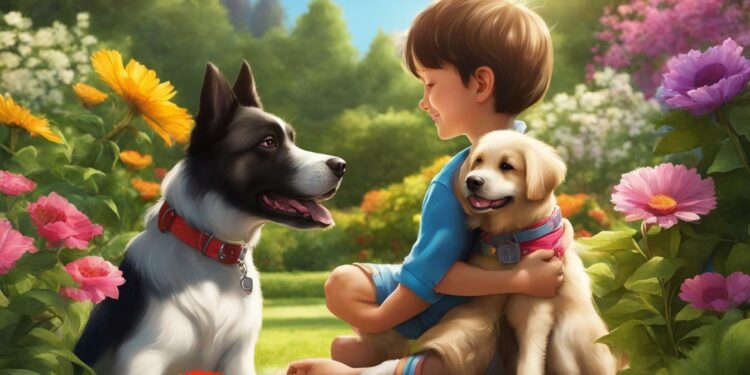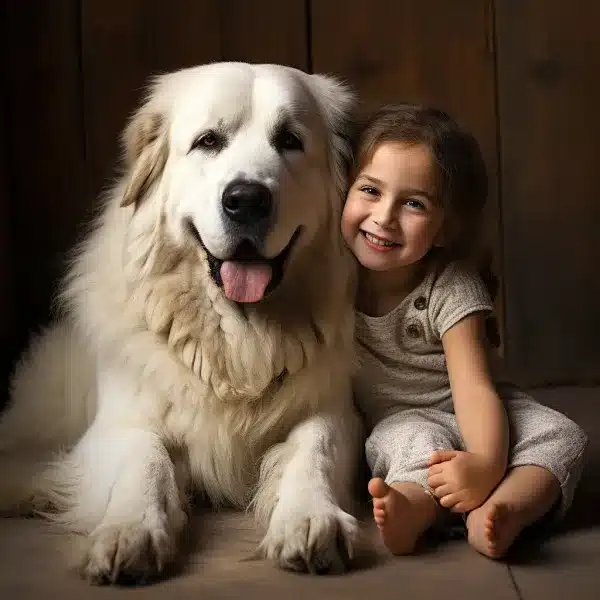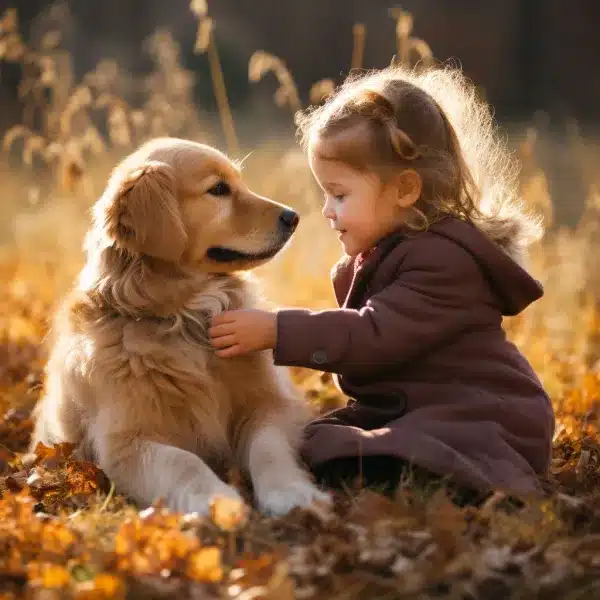Creating Safe Dog-Child Interactions: Essential Tips For Harmony

Safe And Harmonious Relationship Between Dogs And Children: It’s important to have a safe and happy relationship between dogs and kids. As a dog owner or parent, you need to know how to make sure they get along. You can do this by teaching kids how to behave around dogs and watching for signs of stress in dogs. You should also set boundaries, keep toys separate, and avoid rough play. Encouraging appropriate games and supervising interactions helps too. Consistent training and boundaries are crucial for a good relationship between dogs and kids. Additionally, having animal liability insurance provides financial protection in case of unexpected incidents. By following these essential tips, you can create a loving and secure environment where dogs and children can thrive together.
Why Teaching Children Proper Behavior Around Dogs is Essential
Teaching children proper behavior around dogs is essential to prevent accidents and foster a positive relationship. By instilling the importance of respect and understanding, children can develop a lifelong appreciation for these furry companions. Here are some key lessons to teach children when interacting with dogs.
Teaching children proper behavior
- Approach dogs calmly and respectfully: Teach children to approach dogs gently and avoid sudden movements or loud noises that may startle them. This helps create a calm and relaxed environment for both the child and the dog.
- Ask for permission before touching: Emphasize the importance of asking the dog owner or guardian for permission before petting a dog. This teaches children to respect boundaries and ensures that the dog is comfortable with being touched.
- Never disturb a dog while eating or sleeping: Teach children to understand that dogs need their personal space, particularly when they are eating or resting. Disturbing a dog during these times can lead to aggression or anxiety.
- Gentle petting and stroking: Guide children on how to pet a dog gently and avoid pulling on their fur or tail. This helps children develop empathy and sensitivity towards the dog’s feelings.
Remember, every dog is unique, and it’s crucial to teach children to be aware of the dog’s body language and signals. For example, if a dog is showing signs of discomfort such as growling, snarling, or trying to move away, children should understand that these are indications that the dog needs space and should be left alone. By teaching children to be observant and respectful, we can ensure a safe and harmonious relationship between dogs and children.
Teaching children proper behavior around dogs is an ongoing process. It requires consistent guidance and supervision from parents, guardians, and educators. By equipping children with these essential skills, we can create a safe and loving environment for both dogs and children, fostering a positive and lifelong bond.
Understanding Dogs’ Body Language: Signs of Discomfort and Stress
Dogs communicate primarily through their body language, and being able to interpret their signals can prevent potential conflicts and promote positive interactions.
Here are some common signs that indicate a dog may be experiencing discomfort or stress:
- Ears pinned back
- Tail tucked between the legs
- Whale eye (wide-eyed with a lot of white showing in the corner of the eye)
- Yawning or licking lips excessively
- Growling, snarling, or barking
These behaviors may suggest that a dog is feeling anxious, fearful, or threatened. It’s important to respect their signals and give them space to relax and feel safe.
Responding to Signs of Discomfort and Stress
“Dogs communicate primarily through their body language, and being able to interpret their signals can prevent potential conflicts and promote positive interactions.”
If you notice any of these signs in a dog, it’s essential to respond appropriately to prevent any escalation of stress or aggression. Here are some steps you can take:
- Give the dog space: Allow the dog to move away from the situation that is causing them stress. Avoid crowding or cornering them.
- Respect their boundaries: Avoid reaching out to pet a dog that is showing signs of discomfort. Give them the freedom to approach you if they feel comfortable.
- Remove the stressor: Identify and remove any triggers that may be causing the dog’s discomfort. This could include loud noises, excessive handling, or unfamiliar environments.
- Seek professional help if needed: If a dog consistently exhibits signs of stress or discomfort, it may be beneficial to consult with a professional dog trainer or behaviorist.
By understanding and responding to the signs of discomfort and stress in dogs, we can create a safe and harmonious environment for both dogs and children. Teaching children to recognize and respect these signals is also crucial in promoting positive interactions and preventing accidents. Remember, a little understanding goes a long way in nurturing a loving relationship between dogs and children.
| Signs of Discomfort and Stress | Meaning |
|---|---|
| Ears pinned back | Sign of fear or anxiety |
| Tail tucked between the legs | Indicates fear or submission |
| Whale eye | Shows fear or unease |
| Yawning or licking lips excessively | Stress or discomfort |
| Growling, snarling, or barking | Warning signs of aggression or fear |
Recognizing When a Dog Needs Space and Respecting Boundaries
Recognizing when a dog needs space and respecting their boundaries is crucial for creating a safe and harmonious relationship. Dogs, like humans, have their own personal space and comfort zones. It is important to understand and acknowledge these boundaries to prevent any potential conflicts or discomfort for both the dog and the child.
One way to recognize when a dog needs space is by observing their body language. Signs of distress or discomfort may include a tucked tail, lowered ears, or a stiff body posture. If you notice these behaviors, it is essential to give the dog some space and avoid any interactions that may aggravate the situation.
Respecting a dog’s boundaries goes hand in hand with recognizing their needs for personal space. Teach your child to approach a dog calmly and gently, giving the dog the choice to interact or retreat. It is crucial to never force a dog into an unwanted interaction, as this can lead to anxiety, fear, or aggression.
As a responsible dog owner, it is your duty to educate your child about the importance of recognizing when a dog needs space and respecting their boundaries. By doing so, you create a safe environment where both dogs and children can coexist peacefully and enjoy a positive relationship.
| Recognizing When a Dog Needs Space | Respecting Boundaries |
|---|---|
|
|
“Dogs, like humans, have their own personal space and comfort zones. It is important to understand and acknowledge these boundaries to prevent any potential conflicts or discomfort for both the dog and the child.”
Creating a Safe and Loving Environment
Recognizing when a dog needs space and respecting their boundaries is just one piece of the puzzle in creating a safe and harmonious relationship between dogs and children. It is also essential to educate children on proper behavior around dogs, understand dogs’ body language, and encourage the right kind of games and activities. Additionally, supervising interactions, establishing consistent training and boundaries, and having animal liability insurance can further enhance the safety and well-being of both dogs and children.
By understanding and implementing these essential tips, you can create a nurturing environment where dogs and children can thrive together, forming strong bonds built on trust, respect, and love.
Keeping Toys Separate and Avoiding Rough Housing
Keeping toys separate and avoiding rough housing can help prevent conflicts and ensure a safe interaction between dogs and children. Dogs can become possessive of their toys, and when children try to play with them, it may lead to misunderstandings or even aggression. To avoid such situations, it is essential to establish clear boundaries when it comes to toys.
One effective strategy is to designate specific toys for the dog and separate them from the children’s toys. This way, both parties have their own playthings, reducing the chances of any resource guarding or territorial behavior. Additionally, teaching children to respect the dog’s belongings and not to take them away forcefully will help foster a positive and cooperative environment.
Rough housing, although often seen as playful behavior, can sometimes escalate into aggression or accidental injuries. Both dogs and children may not understand their own strength or boundaries, leading to unintended consequences. It is crucial to educate children about the importance of gentle play and avoid any rough behaviors that may cause discomfort or fear in the dog.
When engaging in play, encourage gentle interactions and provide appropriate toys or activities that promote positive engagement without encouraging roughness. For example, interactive puzzle toys or fetch games can be enjoyed by both dogs and children without risking harm. Remember, the goal is to create a safe and enjoyable environment for all parties involved.
| Benefits of Keeping Toys Separate and Avoiding Rough Housing: |
|---|
| Prevents conflicts between dogs and children over toys |
| Reduces the risk of resource guarding or territorial behavior |
| Teaches children to respect the dog’s belongings |
| Minimizes the chances of accidental injuries during play |
| Fosters a positive and cooperative environment |
Encouraging the Right Kind of Games and Activities
Encouraging the right kind of games and activities can foster a safe and enjoyable relationship between dogs and children. By providing appropriate outlets for energy and interaction, you can ensure that both parties are engaged in positive and constructive ways.
One way to promote a healthy dynamic is to create a list of games that are safe and suitable for both dogs and children. Consider games that involve gentle play, such as hide and seek or fetch. These activities allow children to interact with their furry friends while respecting their boundaries and promoting a sense of fun.
It is also important to establish clear rules and boundaries when engaging in games and activities. Teach children to treat dogs with respect and kindness, and discourage any rough play that may lead to accidents or injury. By setting these guidelines, you can create a harmonious environment where both dogs and children feel safe and valued.
| Games and Activities | Benefits |
|---|---|
| Hide and Seek | Encourages problem-solving skills and builds trust between dogs and children |
| Fetch | Promotes physical exercise and strengthens the bond between dogs and children |
| Tug-of-War | Teaches dogs and children about sharing and provides a playful outlet for energy |
To ensure a safe and enjoyable experience, it is crucial to supervise all interactions between dogs and children during games and activities. This allows you to intervene if any signs of discomfort or stress are displayed by either party. By closely monitoring the dynamics and stepping in when necessary, you can prevent potential conflicts and maintain a positive environment for everyone involved.
Supervising Interactions: Ensuring Safety and Positive Engagement
Supervising interactions between dogs and children is vital for their safety and to encourage a positive relationship. By closely monitoring their interactions, you can prevent potential accidents and ensure that both parties feel secure and comfortable. Here are some essential tips for effective supervision:
- Always be present and attentive when dogs and children are together. Do not leave them unsupervised, especially younger children who may not understand appropriate behavior.
- Observe the body language of both the dog and the child. Look for signs of discomfort, stress, or fear, such as a dog growling or a child pulling on a dog’s ears. Intervene immediately if you notice any concerning behavior.
- Teach children how to interact gently and respectfully with dogs. Encourage them to ask permission before approaching a dog and show them the proper way to pet and play with them. Reinforce positive interactions with praise and rewards.
- Set clear boundaries and rules for both dogs and children. Establish designated areas where the dog can retreat to if they need space and teach children to respect those boundaries. This can help prevent conflicts and create a safe environment for everyone.
- As a supervisor, maintain a calm and assertive demeanor. Your presence should provide a sense of security for both dogs and children. Avoid panicking or overreacting in stressful situations, as this can escalate the tension.
Remember, supervising interactions is not only about safety but also about fostering positive engagement between dogs and children. By being mindful and proactive, you can create a harmonious relationship built on trust, respect, and love.
| Key Tips for Supervising Interactions |
|---|
| Always be present and attentive. |
| Observe and understand body language. |
| Teach children gentle and respectful behavior. |
| Set clear boundaries and rules. |
| Maintain a calm and assertive demeanor. |
Establishing Consistent Training and Boundaries
Establishing consistent training and boundaries is essential in creating a harmonious relationship between dogs and children. When both parties understand the expectations and know their limits, it helps prevent misunderstandings and potential conflicts. Consistency in training ensures that dogs and children are on the same page and promotes positive behavior.
To set boundaries, use verbal commands and visual signals. Teach kids to ask before approaching dogs and use a hand signal or word for boundaries. Create a training schedule to establish consistency and routine. Use positive reinforcement, like treats and praise, to encourage following the rules.
| Benefits of Establishing Consistent Training and Boundaries: |
|---|
| 1. Clear expectations for both dogs and children. |
| 2. Prevention of potential conflicts and accidents. |
| 3. Development of respect and understanding between dogs and children. |
| 4. Promotion of positive behavior and interactions. |
“Consistency is key when it comes to training dogs and children. By establishing clear boundaries and sticking to them, you can create a safe and loving environment where both parties can thrive.” – Dr. Sarah Thompson, Animal Behaviorist
In summary, establishing consistent training and boundaries is crucial in ensuring a harmonious relationship between dogs and children. It helps set clear expectations, prevents conflicts, and fosters positive behavior. By implementing appropriate training techniques and maintaining consistency, you can create a safe and loving environment for both dogs and children to thrive.
The Benefits of Animal Liability Insurance
Animal liability insurance protects you from unexpected incidents involving your dog and children. It covers damages or injuries caused by your dog to others or their property. This insurance gives you peace of mind knowing you’re financially protected in case of an accident. It also covers legal expenses, such as attorney fees, court costs, and settlement or judgment amounts. This insurance can provide coverage for medical expenses associated with injuries caused by your dog, including hospital bills, doctor visits, surgeries, and medications. It can alleviate the financial burden of unexpected medical expenses.
| Benefits of Animal Liability Insurance: |
|---|
| Financial protection for damages or injuries caused by your dog |
| Coverage for legal expenses in case of a lawsuit |
| Protection against unexpected medical expenses |
Animal liability insurance helps protect your finances from potential liabilities. Review the policy details and coverage limits to make sure they meet your needs. Talking to an insurance professional can guide you in selecting the right policy for dogs and children.
Conclusion
By understanding and implementing these essential tips, you can create a safe and loving environment for dogs and children. Creating a harmonious relationship between dogs and children is crucial to prevent accidents and ensure the well-being of both parties. Teaching children the right way to behave around dogs is essential, emphasizing positive interactions and associations.
It is also important to understand the subtle body language of dogs that indicates discomfort or stress. By recognizing these signs, you can take appropriate action and provide a supportive environment for your furry friend. Knowing when a dog needs space and respecting their boundaries is key in maintaining a safe environment.
Additionally, keeping toys separate and discouraging rough housing can help prevent potential conflicts between dogs and children. Encouraging the right kind of games and activities that promote positive interactions is also important for their relationship to thrive. Supervising their interactions not only ensures their safety but also encourages positive engagement.
Establishing consistent training and boundaries for both dogs and children is vital in creating a harmonious relationship. This consistency provides structure and clarity, helping them understand their roles and expectations within the household. Lastly, having animal liability insurance offers financial protection in case of unexpected incidents, giving you peace of mind.
By incorporating these essential tips into your daily routine, you can foster a safe and loving environment where dogs and children can grow and flourish together. Remember, their relationship is built on trust, understanding, and respect. With your guidance and love, they can form a bond that will last a lifetime.
FAQ
Q: Why is it important to teach children the right way to behave around dogs?
A: Teaching children the right way to behave around dogs is important to prevent accidents and promote positive interactions between dogs and children. It helps children understand how to approach and interact with dogs in a safe and respectful manner.
Q: What are some signs of discomfort or stress in dogs?
A: Dogs may display signs of discomfort or stress through body language such as cowering, lip licking, yawning, or growling. It’s important to recognize these signs and give them space and time to relax.
Q: How can I recognize when a dog needs space and how should I respect their boundaries?
A: Dogs may exhibit signs of needing space, such as moving away, hiding, or showing signs of fear or anxiety. It’s important to respect their boundaries by not approaching or touching them if they display these behaviors.
Q: Why is it important to keep toys separate and avoid rough housing?
A: Keeping toys separate and avoiding rough housing can prevent potential conflicts between dogs and children. It minimizes the risk of resource guarding behaviors and reduces the chances of accidental injuries.
Q: What kind of games and activities should be encouraged?
A: Suitable games and activities that promote positive interactions and minimize the risk of accidents should be encouraged. This includes gentle play, supervised fetch, or teaching dogs and children new tricks together.
Q: How should interactions between dogs and children be supervised?
A: Interactions between dogs and children should be closely supervised to ensure safety and promote positive engagement. An adult should be present at all times to monitor the interaction, intervene when necessary, and redirect the behavior if needed.
Q: Why is it important to establish consistent training and boundaries?
A: Establishing consistent training and boundaries for dogs and children helps create a harmonious relationship. Consistency provides clear expectations and guidelines for behavior, which can prevent misunderstandings and conflicts.
Q: What are the benefits of having animal liability insurance?
A: Having animal liability insurance provides financial protection in case of unexpected incidents involving dogs and children. It can cover medical expenses or legal costs that may arise from accidents or injuries.
Q: What are some essential tips for creating a safe and harmonious relationship between dogs and children?
A: Essential tips include teaching children proper behavior around dogs, understanding dogs’ body language, recognizing when a dog needs space, keeping toys separate, encouraging suitable games and activities, supervising interactions, establishing consistent training and boundaries, and having animal liability insurance for added protection.








